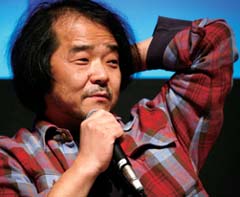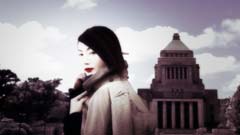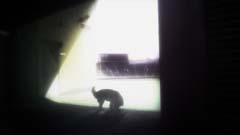Interview with Mamoru Oshii - Part II
Turning memories of post-war relics into entertainment
 | Mamoru Oshii Born in Tokyo on August 8, 1951, Mamoru Oshii is one of the most remarkable personalities in modern Japanese filmmaking. He introduced introspective philosophical speculation into the world of animation, influencing at the same time movie creators all around the globe with his visionary style. Oshii joined the animation industry in 1977. His main works are Urusei Yatsura 2: Beautiful Dreamer (1984) the epoch-making Ghost in the Shell (1995) and Innocence (2004, nominated for the Palme d'Or at the Festival de Cannes). Oshii has also directed a number of live-action features, including Avalon (2001). Tachigui: The Amazing Lives of the Fast Food Grifters , based on his own novel, released in Japan on April 8, 2006, had its international premiere at the 63rd Venice Film Festival. |
The main subject of the film, covered in the first half, has been depicted many times in your works up to now. I can see how certain pathos and sentimentalism that permeated the days in which Japan was moving from the post-war ashes to the economic miracle, have been transposed onto each of the characters.
But the Moongaze Ginji character is a figment of my imagination. That's why I say in the movie that he's a "legend." I mean, he is from an era that I do not have any direct experience of. I could not possibly know the black market days, after all. But still, I did live in a time when that world could be clearly recalled. There was still evidence of the air raids. I was able to perceive what the war did in a physical sense, since the sight of injured soldiers or men with missing limbs was a matter of daily life. As a kid, I could imagine how the country had been at war recently and that we got totally thrashed. Our parents would raise us severely repeating, "Those were days of mayhem, but now we live in good times." At the same time, comic magazines for children would claim, "We could've won the war if we had two more Yamato-class battleships." Or, "We might've won if we possessed super bombers." There were special features like that out all the time. It seems kind of strange now, but Moongaze Ginji was born out of that kind of imagination.
Would you say that the point where the story reflects some of your actual experiences is the next segment about Foxy Croquette O-Gin?
I suppose. I came into my own around the time of the 1960 Anpo demonstrations. After all, I remember the time when NHK made its first broadcast.

Do you find that you had a child-like sense of enchantment?
Of course. I was full of dreams about the future and that we were "surely headed for good times." But that was only for a brief instant. (laughs) This optimism quickly turned into hopelessness, therefore I wanted to depict through my own memories the turning point when the times changed. And the culmination of this was the self-denial of Cold Badger Masa. This was the moment when those optimistic times ended for me.
But his murder scene was depicted very much in a manga style. You seem to have avoided a more realistic depiction.
I think I can say this for the entire film, but I have totally avoided any sort of realism. For example, even with the Tokyo Olympics segment, I decided to show an empty Yoyogi National Stadium. It's not that difficult to use graphics to stick spectators in there. But in my image, that stadium is a place that has no one in the stands. I was actually there, although it wasn't the opening ceremonies, as I obviously could not afford such an expensive ticket. (laughs) I think I went to one of the early 100-meter hurdle heats, but I felt that there was no one there. I mean, the people around me in the stands weren't looking at anyone. It was too far a distance from where the competition was taking place. There was no way you could see anything. I'm not kidding. The Japanese people were following the Games reading magazines and watching TV. Even though I had made my way to the National Stadium, I wasn't able to see anything. It was like, "They're doing something over there."

Did you enjoy the process of facing up to your memories and developing a story out of them?
It was fun. It's like I add on my memories to this piece of entertainment, or add on my mischief. For example, in the case of the "little finger croquette," it was well known that such an incident occurred. It was in the papers at the time. So, I wondered what a "little finger croquette" would look like. In actual fact, it was simply that a female worker at the factory making the croquettes got her finger stuck and torn off. But I decided to show a croquette with many little pinkies, some of which were playfully crossed. So, while this is entertainment, it is also a sort of mischief on my part. You know, I was just doing it out of fun.
(2 - to be continued)
This interview was originally collected in Japanese by Shotaro Miya
© 2006 MAMORU OSHII, Production I.G / TACHIGUISHI RETSUDEN Committee

![WORK LIST[DETAILS]](/contents/works/design/images/left_title.gif)



 terms of use
terms of use